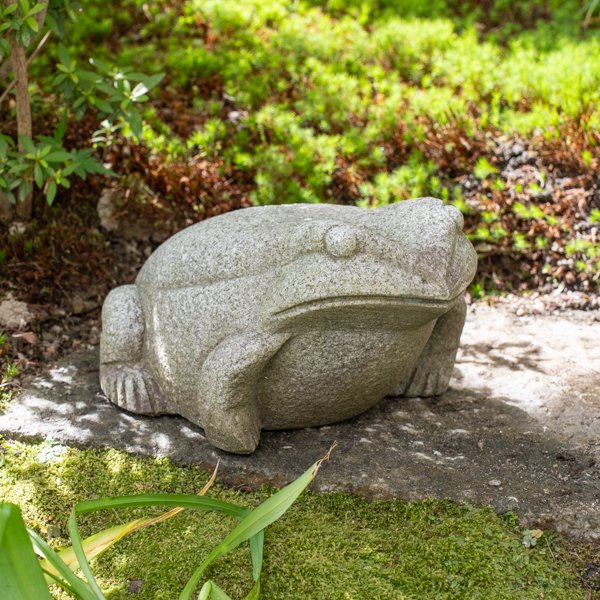カエル | Frog
70,000円(税込77,000円)
English Follows Japanese Below
日本の文化において、カエルは幸運と豊かさを象徴する存在とされています。水辺に生息する姿から、豊かな生活や繁栄を連想させます。家族の結びつきや財産が帰ってくるようにとの願いを込めた「カエル」という語呂合わせも、縁起物として親しまれる理由の一つです。

真壁石は、茨城県桜井市真壁地区で採石される花崗岩です。この一帯は古くから良質な花崗岩の産地として知られ、明治までは「常陸小みかげ」と呼ばれていました。赤坂離宮にも使用されている石材で、関東地区を中心に、国産みかげの代表として知られています。青みを帯びた優しい色目が特徴で、経年により青みが一層増してきます。風化しにくいながらも、使うほどに味が出てくるのが、真壁石の魅力です。吸水率は低くはありませんが、水はけが良く、美しい石目が長年お楽しみいただけます。


素材:茨城県産真壁石
高さ:13.5㎝
横幅:21㎝
奥行:29㎝
重さ:9 kg
・ 重量がある商品ですので、持ち上げる際には、両手でしっかりと持ってください。
・ 石材は欠けやすいので、物にぶつかったりしないようにご注意ください。
In Japanese culture, frogs are considered to symbolize good luck and abundance. As they live near water, they are associated with a rich life and prosperity. The word "kaeru" (frog) sounds similar to the Japanese word for "frog," and it carries with it the wish for family ties and the return of wealth, which is one of the reasons why they are popular as lucky charms.
Makabe stone is granite quarried in the Makabe district of Sakurai City, Ibaraki Prefecture. This area has long been known as a source of high-quality granite, and was known as "Hitachi Ko Mikage" until the Meiji period. It is the stone material used in Akasaka Imperial Villa, and is known as a representative of domestically produced Mikage, especially in the Kanto region. It is characterized by a gentle bluish color that deepens with age. The appeal of Makabe stone is that it is resistant to weathering, but develops a unique character the more it is used. Although it does not absorb water easily, it has good drainage and the beautiful stone grain can be enjoyed for many years.
Material: Ibaraki Prefecture's Makabe
Height: 13.5 cm
Width: 21 cm
Depth: 29 cm
Weight: 9 kg
Due to its weight, when lifting, please ensure to hold it firmly with both hands.
As stone is prone to chipping, exercise caution to prevent it from hitting other objects.
We also accept custom-made stone products. Please feel free to inquire and discuss your preferences through our contact form.
Contact Form
商品を購入する | Buy The Product
カエルは幸運や繁栄を呼ぶ、日本の伝統的な縁起物です。
日本の文化において、カエルは幸運と豊かさを象徴する存在とされています。水辺に生息する姿から、豊かな生活や繁栄を連想させます。家族の結びつきや財産が帰ってくるようにとの願いを込めた「カエル」という語呂合わせも、縁起物として親しまれる理由の一つです。

国産みかげ石の代表格、茨城県産真壁石を使用
真壁石は、茨城県桜井市真壁地区で採石される花崗岩です。この一帯は古くから良質な花崗岩の産地として知られ、明治までは「常陸小みかげ」と呼ばれていました。赤坂離宮にも使用されている石材で、関東地区を中心に、国産みかげの代表として知られています。青みを帯びた優しい色目が特徴で、経年により青みが一層増してきます。風化しにくいながらも、使うほどに味が出てくるのが、真壁石の魅力です。吸水率は低くはありませんが、水はけが良く、美しい石目が長年お楽しみいただけます。


商品詳細
素材:茨城県産真壁石
高さ:13.5㎝
横幅:21㎝
奥行:29㎝
重さ:9 kg
ご使用上の注意
・ 重量がある商品ですので、持ち上げる際には、両手でしっかりと持ってください。
・ 石材は欠けやすいので、物にぶつかったりしないようにご注意ください。
オーダーメイドの石造品製作も承っております。お問い合わせフォームにて、お気軽にご相談ください。
お問い合わせフォーム
Frogs are traditional Japanese lucky charms that bring good luck and prosperity.
In Japanese culture, frogs are considered to symbolize good luck and abundance. As they live near water, they are associated with a rich life and prosperity. The word "kaeru" (frog) sounds similar to the Japanese word for "frog," and it carries with it the wish for family ties and the return of wealth, which is one of the reasons why they are popular as lucky charms.
Using the Representative Ibaraki Stone, Domestically Produced Granite
Makabe stone is granite quarried in the Makabe district of Sakurai City, Ibaraki Prefecture. This area has long been known as a source of high-quality granite, and was known as "Hitachi Ko Mikage" until the Meiji period. It is the stone material used in Akasaka Imperial Villa, and is known as a representative of domestically produced Mikage, especially in the Kanto region. It is characterized by a gentle bluish color that deepens with age. The appeal of Makabe stone is that it is resistant to weathering, but develops a unique character the more it is used. Although it does not absorb water easily, it has good drainage and the beautiful stone grain can be enjoyed for many years.
Specifications
Material: Ibaraki Prefecture's Makabe
Height: 13.5 cm
Width: 21 cm
Depth: 29 cm
Weight: 9 kg
Usage Precautions
Due to its weight, when lifting, please ensure to hold it firmly with both hands.
As stone is prone to chipping, exercise caution to prevent it from hitting other objects.
We also accept custom-made stone products. Please feel free to inquire and discuss your preferences through our contact form.
Contact Form






